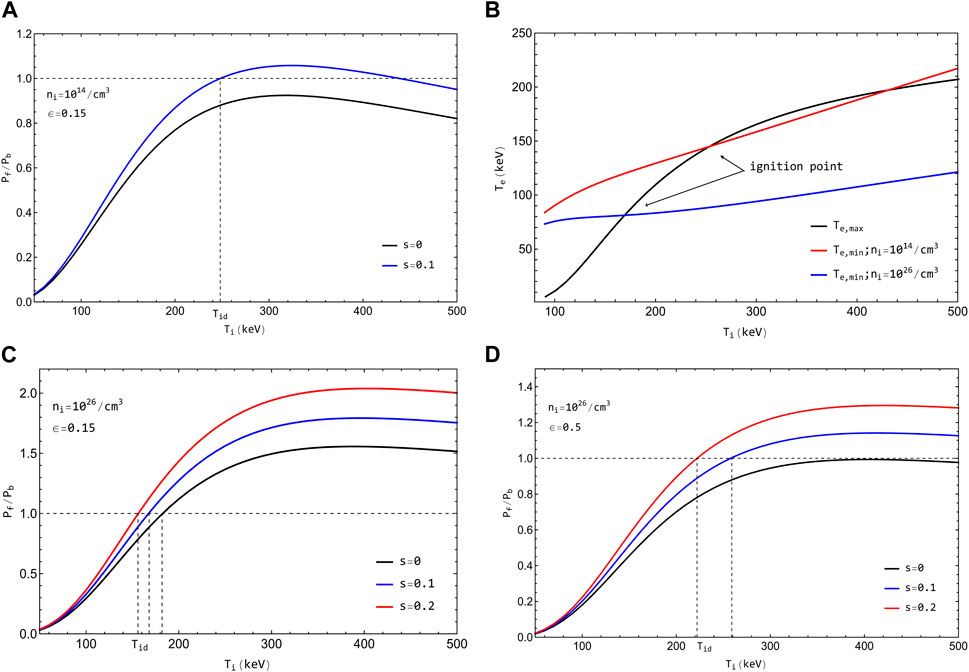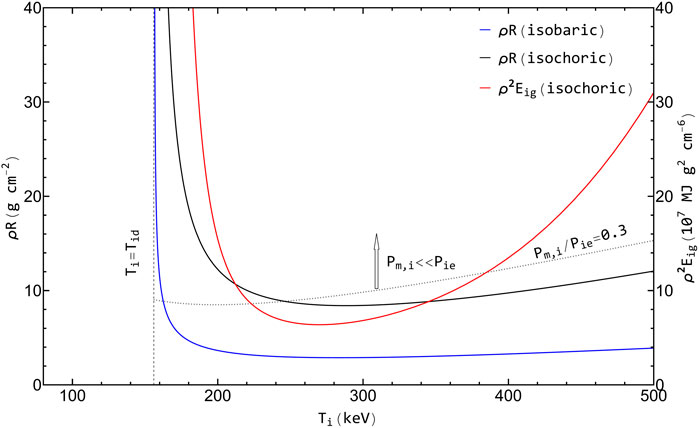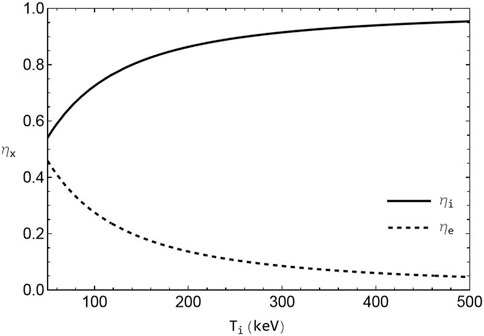- 1HB11 Energy Holdings Ltd Pty, Sydney, NSW, Australia
- 2School of Electrical Engineering and Telecommunications, Faculty of Engineering, UNSW Sydney, Kensington, NSW, Australia
We have revisited recent results on the ideal ignition of H11B fuel, in the light of the latest available reactivity, an alternative self-consistent calculation of the electron temperature, an increased extent of the suprathermal effects and the impact of plasma density. At high density, we find that the ideal ignition temperature is appreciably relaxed (e.g.,
1 Introduction
The 11B(p,3α) fusion reaction, with a Q-value of 8.6 MeV, is experiencing a renewed interest for energy production purposes, in the light of recent experimental and theoretical findings [1–11]. The reaction is aneutronic and involves only abundant and stable isotopes. Moreover, the α particles in its final state may release all their energy to the fusion plasma. The reaction is also of interest for studies in stellar evolution, where relative abundances of 11B, Li and Be provide insight into stellar processes [12]. Proposed approaches for energy production span magnetic [13], magneto-inertial [14, 15] and laser-driven [5, 16, 17] fusion. The exploitation of H11B fuel, however, remains extremely challenging because of its low reactivity and high radiative losses at temperatures attainable in present-day fusion devices.
The existence of ideal ignition conditions has been demonstrated only lately by Putvinski et al. [6], who have used a recent fusion cross section dataset [4] for the calculation of the thermal reactivity and added to this latter a contribution coming from kinetic (particularly, suprathermal) effects, calculated self-consistently. Suprathermal effects are due to elastic collisions between the fusion-born α′s and background thermal protons [6, 18], which develop a bolder tail in the proton energy spectrum compared to the Maxwell-Boltzmann distribution [19–21]. Putvinski et al. [6] have found fusion power to overcome bremsstrahlung losses only marginally, for
In this Brief Research Report, we first revisit those findings in the light of the latest available reactivity, an alternative self-consistent calculation of
We recall that hot-spot fuel configurations are relevant to laser-driven inertial confinement, which is a promising method to achieve fusion energy [22]. Ignition of DT fuel has recently been achieved at the US National Ignition Facility [23], by exploiting an indirect-drive scheme based on a nearly isobaric fuel configuration [24]. Fast ignition is a technique alternative to hot-spot ignition and is based on the ignition of precompressed fuel by means of an external trigger. Laser-driven fast ignition was proposed by Tabak et al. [25] 30 years ago and it is today the subject of significant theoretical and experimental investigation [26, 27].
2 Ideal ignition
The ideal ignition conditions of Putvinski et al. [6] have been recalculated and plotted in Figure 1A (blue curve) in terms of the ratio
is the fusion power (per unit volume),

Figure 1. (A) Revisit of Putvinski et al’s ideal ignition and burn conditions [6], at low plasma density. (B)
From Figure 1A, we note that ignition is not possible if the suprathermal contribution is not accounted for (
As for the self-consistent calculation of
where
which yields slightly higher values of
While ignition and self-burn appear less marginal than previously found, low-density plasmas remain of a primary interest for magnetic confinement approaches, which can operate at sub-ignition. More meaningful conclusions can be drawn for ignition-based schemes, at high density. While the explicit square-density dependence of the P-terms cancels out in Eqs 2, 3, a residual dependence on density remains in Eq. 3 through the Coulomb logarithms of
As
The high
3 Hot-spot ignition
The power balance condition for a hot spot of radius R and density ρ at the ignition threshold reads
where
where

Figure 2. Left-hand ordinate: Confinement parameter vs.
By analogy with the DT and DD cases, we expect that 1D simulations of pre-assembled fuel would actually show a lower branch of the ignition curves in the proximity of and after their knee, due to a cooling/re-heating mechanism of the hot spot for initial points located just below the analytic curves [32–35]. In the case of isochoric DT, for instance,
Although the confinement parameter is high at the minimum of ignition curves, we have checked that the plasma is still optically thin, i.e., the Planck mean free path,
is the free-free Planck mean opacity [35], with
For instance,
The ignition energy,
where V is the volume of the plasma sphere and p is its pressure, as given by
The quantity
4 Discussion and conclusion
Despite the fact that self-heating is possible in a pre-formed hot spot, we have verified that implosion-driven formation of the hot spot is hydrodynamically impossible, on the basis of the same argument preventing it in pure D fuel [34], i.e., a cooling timescale shorter than the hot-spot confinement time
Proton fast ignition [36] is particularly suited to H11B fuel, not only because of its superior ballistic properties in the energy deposition and the potential capability of inducing the hot-ion mode, but also because of the additional heating provided by the in-flight fusion reactions of the proton beam [21, 37]. It has been put forward [21] that in a fully degenerate 11B plasma, under certain conditions, this contribution could become as large as the initial kinetic energy of the proton beam. Such an effect could then appreciably reduce the ignitor energy required in a H11B mixture. Taking also into account the reduction of
The ignitor pulse will have to be delivered to the compressed target within a timescale shorter than
With a 300 kJ ignitor and the highest reported laser-to-proton energy conversion efficiency, 15% [41, 42], an overall laser energy of 2 MJ will be needed to drive the ignitor. This energy will have to be delivered to the foil target over a timescale of 1 ps. Suitable laser amplifiers and laser architectures will have to be developed to this extent as well as for the ns-scale implosion of the fuel, where driver energies above 10 MJ are expected. Both Diode-Pumped Solid-State Laser (DPSSL) and excimer laser systems show the potential to be scaled up to the large energy outputs required for compression and fast ignition of H11B fuel, on both the ns and ps timescales [43, 44].
We finally recall that within the frame of a very specific fast ignition scheme, based on a laser-driven relativistic shock wave, Eliezer et al. [45] have found that a laser pulse with intensity of 1.6 × 1025 W/cm2, duration of 1 ps and energy of 21 MJ impinging on fuel pre-compressed at 4,800 g/cm3 can generate a side, cylindrical hot spot with a depth of 8.3 g/cm2,
On the contrary, our preliminary analysis shows that proton fast ignition of isochoric H11B fuel requires compression and ignitor performances which, though challenging, are in line with near-future laser capabilities. We plan to devote further work to demonstrate burn propagation, better quantify ignition parameters and calculate gain in such scheme, considering actual target configurations.
Data availability statement
The original contributions presented in the study are included in the article/Supplementary Material, further inquiries can be directed to the corresponding author.
Author contributions
EG: Formal Analysis, Writing–original draft, Writing–review and editing, Data curation, Investigation, Software, Visualization. FB: Formal Analysis, Writing–original draft, Writing–review and editing, Conceptualization, Methodology, Supervision, Validation.
Funding
The author(s) declare that financial support was received for the research, authorship, and/or publication of this article. HB11 Energy Ltd. Pty. has supported this work through the consultancy contract of the first author and the payment of the publishing fee. This work has been carried out under the Collaborative Science Program of HB11 Energy.
Acknowledgments
The authors wish to thank D Batani, S Pikuz, E Turcu and D Margarone for useful discussions. The authors are indebted with I Morozov for an independent verification of their results. FB is grateful to F Ladouceur for hosting his fellowship at UNSW Sydney.
Conflict of interest
Author EG was affiliated to HB11 Energy Holdings Ltd Pty.
The remaining author declares that the research was conducted in the absence of any commercial or financial relationships that could be construed as a potential conflict of interest.
The authors declare that this study received funding from HB11 Energy Pty. Ltd. The funder was involved in the discussion of the results and in the decision to submit the manuscript for publication.
Publisher’s note
All claims expressed in this article are solely those of the authors and do not necessarily represent those of their affiliated organizations, or those of the publisher, the editors and the reviewers. Any product that may be evaluated in this article, or claim that may be made by its manufacturer, is not guaranteed or endorsed by the publisher.
References
1. Belyaev VS, Matafonov AP, Vinogradov VI, Krainov VP, Lisitsa VS, Roussetski AS, et al. Observation of neutronless fusion reactions in picosecond laser plasmas. Phys Rev E (2005) 72:026406. doi:10.1103/physreve.72.026406
2. Stave S, Ahmed MW, France RH, Henshaw SS, Müller B, Perdue BA, et al. Understanding the B11(p,α)αα reaction at the 0.675 MeV resonance. Phys Lett B (2011) 696:26–9. doi:10.1016/j.physletb.2010.12.015
3. Labaune C, Baccou C, Depierreux S, Goyon C, Loisel G, Yahia V, et al. Fusion reactions initiated by laser-accelerated particle beams in a laser-produced plasma. Nat Commun (2013) 4:2506. doi:10.1038/ncomms3506
4. Sikora MH, Weller HR. A new evaluation of the 11B(p, α) α α reaction rates. J Fusion Energ (2016) 35:538–43. doi:10.1007/s10894-016-0069-y
5. Hora H, Eliezer S, Kirchhoff G, Nissim N, Wang J, Lalousis P, et al. Road map to clean energy using laser beam ignition of boron-hydrogen fusion. Laser Part Beams (2017) 35:730–40. doi:10.1017/s0263034617000799
6. Putvinski S, Ryutov D, Yushmanov P. Fusion reactivity of the pB11 plasma revisited. Nucl Fusion (2019) 59:076018. doi:10.1088/1741-4326/ab1a60
7. Giuffrida L, Belloni F, Margarone D, Petringa G, Milluzzo G, Scuderi V, et al. High-current stream of energetic α particles from laser-driven proton-boron fusion. Phys Rev E (2020) 101:013204. doi:10.1103/PhysRevE.101.013204
8. Magee RM, Ogawa K, Tajima T, Allfrey I, Gota H, McCarroll P, et al. First measurements of p11B fusion in a magnetically confined plasma. Nat Commun (2023) 14:955. doi:10.1038/s41467-023-36655-1
9. Ning X, Liang T, Wu D, Liu S, Liu Y, Hu T, et al. Laser-driven proton-boron fusions: influences of the boron state. Laser Part Beams (2022) 2022:e8. doi:10.1155/2022/9868807
10. Margarone D, Bonvalet J, Giuffrida L, Morace A, Kantarelou V, Tosca M, et al. In-target proton–boron nuclear fusion using a PW-class laser. Appl Sci (2022) 12:1444. doi:10.3390/app12031444
11. Turcu ICE, Margarone D, Giuffrida L, Picciotto A, Spindloe C, Robinson APL, et al. Borane (BmHn), Hydrogen rich, Proton Boron fusion fuel materials for high yield laser-driven Alpha sources. JINST (2024) 19:C03065. doi:10.1088/1748-0221/19/03/C03065
12. Boesgaard AM, Deliyannis CP, Steinhauer A. Boron depletion in F and G dwarf stars and the beryllium-boron correlation. Astrophys J (2005) 621:991–8. doi:10.1086/427687
13. Rostoker N, Binderbauer MW, Monkhorst HJ. Colliding beam fusion reactor. Science (1997) 278:1419–22. doi:10.1126/science.278.5342.1419
14. Ghorbanpour E, Ghasemizad A, Khoshbinfar S. Non-equilibrium ignition criterion for p-11B advanced fuel in magnetized target fusion. Phys Part Nucl Lett (2020) 17:809–20. doi:10.1134/S1547477120060126
15. Lerner EJ, Hassan SM, Karamitsos-Zivkovic I, Fritsch R. Focus fusion: overview of progress towards p-B11 fusion with the dense plasma focus. J Fusion Energ (2023) 42:7. doi:10.1007/s10894-023-00345-z
16. McKenzie W, Batani D, Mehlhorn TA, Margarone D, Belloni F, Campbell EM, et al. HB11—understanding hydrogen-boron fusion as a new clean energy source. J Fusion Energ (2023) 42:17. doi:10.1007/s10894-023-00349-9
17. Ruhl H, Korn G. Uniform volume heating of mixed fuels within the ICF paradigm (2023). arXiv:2302.06562.
18. Belloni F, Margarone D, Picciotto A, Schillaci F, Giuffrida L. On the enhancement of p-11B fusion reaction rate in laser-driven plasma by α → p collisional energy transfer. Phys Plasmas (2018) 25:020701. doi:10.1063/1.5007923
19. Weaver T, Zimmerman G, Wood L. Preprint UCRL-74938. Livermore, CA, USA: Lawrence Livermore Laboratory (1973).
20. Belloni F. On a fusion chain reaction via suprathermal ions in high-density H–11B plasma. Plasma Phys Control Fusion (2021) 63:055020. doi:10.1088/1361-6587/abf255
21. Belloni F. Multiplication processes in high-density H-11B fusion fuel. Laser Part Beams (2022) 2022:3952779. doi:10.1155/2022/3952779
22. Meier WR, Dunne AM, Kramer KJ, Reyes S, Anklam TM. Fusion technology aspects of laser inertial fusion energy (LIFE). Fusion Eng Des (2014) 89(9–10):2489–92. doi:10.1016/j.fusengdes.2013.12.021
23. Abu-Shawareb H, Acree R, Adams P, Adams J, Addis B, Aden R, et al. Achievement of target gain larger than unity in an inertial fusion experiment. Phys Rev Lett (2024) 132:065102. doi:10.1103/physrevlett.132.065102
24. Patel PK, Springer PT, Weber CR, Jarrott LC, Hurricane OA, Bachmann B, et al. Hotspot conditions achieved in inertial confinement fusion experiments on the National Ignition Facility. Phys Plasmas (2020) 27:050901. doi:10.1063/5.0003298
25. Tabak M, Hammer J, Glinsky ME, Kruer WL, Wilks SC, Woodworth J, et al. Ignition and high gain with ultrapowerful lasers. Phys Plasmas (1994) 1(5):1626–34. doi:10.1063/1.870664
26. Zhang J, Wang WM, Yang XH, Wu D, Ma YY, Jiao JL, et al. Double-cone ignition scheme for inertial confinement fusion. Philos Trans R Soc A (2020) 378:20200015. doi:10.1098/rsta.2020.0015
27. Xu Z, Wu F, Jiang B, Kawata S, Zhang J. Formation of hot spots at end-on pre-compressed isochoric fuels for fast ignition. Nucl Fusion (2023) 63:126062. doi:10.1088/1741-4326/ad08e6
28. Tentori A, Belloni F. Revisiting p-11B fusion cross section and reactivity, and their analytic approximations. Nucl Fusion (2023) 63:086001. doi:10.1088/1741-4326/acda4b
29. Moreau DC. Potentiality of the proton-boron fuel for controlled thermonuclear fusion. Nucl Fusion (1977) 17:13–20. doi:10.1088/0029-5515/17/1/002
30. Nevins WM. A review of confinement requirements for advanced fuels. J Fusion Energ (1998) 17:25–32. doi:10.1023/a:1022513215080
31. Chirkov AY, Kazakov KD. Radiation limit for the energy gain of the p–11B reaction. Plasma (2023) 6:379–92. doi:10.3390/plasma6030026
32. Gus’kov SY, Krokhin ON, Rozanov VB. Similarity solution of thermonuclear burn wave with electron and α-conductivities. Nucl Fusion (1976) 16:957–62. doi:10.1088/0029-5515/16/6/007
33. Atzeni S, Caruso A. Inertial confinement fusion: ignition of isobarically compressed D-T targets. Nuovo Cim B (1984) 80:71–103. doi:10.1007/bf02899374
34. Basko M. Spark and volume ignition of DT and D2microspheres. Nucl Fusion (1990) 30:2443–52. doi:10.1088/0029-5515/30/12/001
36. Roth M, Cowan TE, Key MH, Hatchett SP, Brown C, Fountain W, et al. Fast ignition by intense laser-accelerated proton beams. Phys Rev Lett (2001) 86:436–9. doi:10.1103/PhysRevLett.86.436
37. Mehlhorn TA, Labun L, Hegelich BM, Margarone D, Gu MF, Batani D, et al. Path to increasing p-B11 reactivity via ps and ns lasers. Laser Part Beams (2022) 2022:2355629. doi:10.1155/2022/2355629
38. Honrubia JJ, Murakami M. Ion beam requirements for fast ignition of inertial fusion targets. Phys Plasmas (2015) 22:012703. doi:10.1063/1.4905904
39. Snavely R, Key MH, Hatchett SP, Cowan TE, Roth M, Phillips TW, et al. Intense high-energy proton beams from Petawatt-laser irradiation of solids. Phys Rev Lett (2000) 85:2945–8. doi:10.1103/PhysRevLett.85.2945
40. Temporal M, Honrubia JJ, Atzeni S. Numerical study of fast ignition of ablatively imploded deuterium–tritium fusion capsules by ultra-intense proton beams. Phys Plasmas (2002) 9:3098–107. doi:10.1063/1.1482375
41. Brenner C, Robinson APL, Markey K, Scott RHH, Gray RJ, Rosinski M, et al. High energy conversion efficiency in laser-proton acceleration by controlling laser-energy deposition onto thin foil targets. Appl Phys Lett (2014) 104:081123. doi:10.1063/1.4865812
42. Zimmer M, Scheuren S, Ebert T, Schaumann G, Schmitz B, Hornung J, et al. Analysis of laser-proton acceleration experiments for development of empirical scaling laws. Phys Rev E (2021) 104:045210. doi:10.1103/physreve.104.045210
43. US DoE Office of Science. Report of the fusion energy sciences workshop on inertial fusion energy (2022). Available from: https://science.osti.gov/-/media/fes/pdf/workshop-reports/2023/IFE-Basic-Research-Needs-Final-Report.pdf. (Accessed January, 2024)
44. Mehlhorn TA. From KMS fusion to HB11 energy and xcimer energy, a personal 50 year IFE perspective. Phys Plasmas (2024) 31:020602. doi:10.1063/5.0170661
45. Eliezer S, Henis Z, Nissim N, Pinhasi SV, Val JM. Introducing a two temperature plasma ignition in inertial confined targets under the effect of relativistic shock waves: the case of DT and pB11. Laser Part Beams (2015) 33:577–89. doi:10.1017/s0263034615000701
46. Svensson R. Electron-positron pair equilibria in relativistic plasmas. Astrophys J (1982) 258:335. doi:10.1086/160082
48. Levush B, Cuperman S. On the potentiality of the proton-boron fuel for inertially confined fusion. Nucl Fusion (1982) 22:1519–25. doi:10.1088/0029-5515/22/11/005
49. Corman EG, Loewe WE, Cooper GE, Winslow AM. Multi-group diffusion of energetic charged particles. Nucl Fusion (1975) 15:377–86. doi:10.1088/0029-5515/15/3/003
Appendix A: Formalism
Power density terms
Explicit expressions for the power density terms in Eqs 1–6 are given hereafter (electrostatic cgs units are used):
where
where
is the classical heat exchange rate [29],
is its relativistic correction [6], and
according to Spitzer [47];
where
is the Spitzer thermal conductivity, with
where
Fusion energy partition and stopping power
The fusion power fraction to ions,
has been used for the fusion-born α particles, with

FIGURE A1. Fusion power fraction to ions (electrons) as a function of
Useful relations
The densities
with
Keywords: proton-boron fusion, inertial confinement fusion, hot-spot ignition, proton fast ignition, laser boron fusion, aneutronic fusion
Citation: Ghorbanpour E and Belloni F (2024) On the ignition of H11B fusion fuel. Front. Phys. 12:1405435. doi: 10.3389/fphy.2024.1405435
Received: 22 March 2024; Accepted: 24 June 2024;
Published: 05 August 2024.
Edited by:
Eliezer Shalom, Soreq Nuclear Research Center, IsraelReviewed by:
Zohar Henis, Soreq Nuclear Research Center, IsraelDimitri Batani, Université de Bordeaux, France
Fuyuan Wu, Shanghai Jiao Tong University, China
Copyright © 2024 Ghorbanpour and Belloni. This is an open-access article distributed under the terms of the Creative Commons Attribution License (CC BY). The use, distribution or reproduction in other forums is permitted, provided the original author(s) and the copyright owner(s) are credited and that the original publication in this journal is cited, in accordance with accepted academic practice. No use, distribution or reproduction is permitted which does not comply with these terms.
*Correspondence: Fabio Belloni, Zi5iZWxsb25pQHVuc3cuZWR1LmF1
†Present address: Fabio Belloni, European Commission, Directorate-General for Research and Innovation, Euratom Research, Brussels, Belgium
 Esmat Ghorbanpour
Esmat Ghorbanpour Fabio Belloni
Fabio Belloni